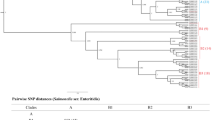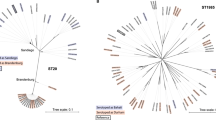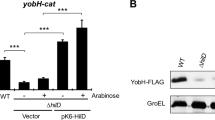Abstract
Salmonella enterica serovars often have a broad host range, and some cause both gastrointestinal and systemic disease. But the serovars Paratyphi A and Typhi are restricted to humans and cause only systemic disease. It has been estimated that Typhi arose in the last few thousand years. The sequence and microarray analysis of the Paratyphi A genome indicates that it is similar to the Typhi genome but suggests that it has a more recent evolutionary origin. Both genomes have independently accumulated many pseudogenes among their ∼4,400 protein coding sequences: 173 in Paratyphi A and ∼210 in Typhi. The recent convergence of these two similar genomes on a similar phenotype is subtly reflected in their genotypes: only 30 genes are degraded in both serovars. Nevertheless, these 30 genes include three known to be important in gastroenteritis, which does not occur in these serovars, and four for Salmonella-translocated effectors, which are normally secreted into host cells to subvert host functions. Loss of function also occurs by mutation in different genes in the same pathway (e.g., in chemotaxis and in the production of fimbriae).
This is a preview of subscription content, access via your institution
Access options
Subscribe to this journal
Receive 12 print issues and online access
$209.00 per year
only $17.42 per issue
Buy this article
- Purchase on Springer Link
- Instant access to full article PDF
Prices may be subject to local taxes which are calculated during checkout


Similar content being viewed by others
References
Ivanoff, B. Typhoid fever: global situation and WHO recommendations. Southeast Asian J. Trop. Med. Public Health 26, 1–6 (1995).
Parry, C.M., Hien, T.T., Dougan, G., White, N.J. & Farrar, J.J. Typhoid fever. N. Engl. J. Med. 347, 1770–1782 (2002).
Sood, S. et al. Paratyphoid fever in India: An emerging problem. Emerg. Infect. Dis. 5, 483–484 (1999).
Hafiz, S. et al. Epidemiology of salmonellosis and its sensitivity in Karachi. J. Pak. Med. Assoc. 43, 178–179 (1993).
Akinyemi, K.O. et al. Prevalence of multi-drug resistant Salmonella typhi among clinically diagnosed typhoid fever patients in Lagos, Nigeria. Z. Naturforsch. [C] 55, 489–493 (2000).
Pearson, R.D. & Guerrant, R.L. Enteric fever and other causes of abdominal symptoms with fever. in Principles Practices of Infectious Diseases (eds. Mandell, G.L., Bennet, J.E. & Dolin, R.) 998–1012 (Churchill Livingstone, New York, 1995).
Threlfall, E.J. et al. Trends in antimicrobial drug resistance in Salmonella enterica serotypes Typhi and Paratyphi A isolated in Europe, 1999-2001. Int. J. Antimicrob. Agents 22, 487–491 (2003).
Smith, J., Leke, R., Adams, A. & Tangermann, R.H. Certification of polio eradication: process and lessons learned. Bull. World Health Organ. 82, 24–30 (2004).
Konadu, E.Y. et al. Phase 1 and phase 2 studies of Salmonella enterica serovar paratyphi A O-specific polysaccharide-tetanus toxoid conjugates in adults, teenagers, and 2- to 4-year-old children in Vietnam. Infect. Immun. 68, 1529–1534 (2000).
Porwollik, S., Wong, R.M. & McClelland, M. Evolutionary genomics of Salmonella: gene acquisitions revealed by microarray analysis. Proc. Natl. Acad. Sci. USA 99, 8956–8961 (2002).
Chan, K. et al. Genomic comparison of Salmonella enterica serovars and Salmonella bongori by use of an S. enterica serovar Typhimurium DNA microarray. J. Bacteriol. 185, 553–563 (2003).
Porwollik, S. et al. Characterization of Salmonella enterica subspecies I genovars using microarrays. J. Bacteriol. 186, 5883–5898 (2004).
Reeves, P. Evolution of Salmonella O antigen variation by interspecific gene transfer on a large scale. Trends Genet. 9, 17–22 (1993).
Kidgell, C. et al. Salmonella typhi, the causative agent of typhoid fever, is approximately 50,000 years old. Infect. Genet. Evol. 2, 39–45 (2002).
Boyd, E.F. et al. Salmonella reference collection B (SARB): strains of 37 serovars of subspecies I. J. Gen. Microbiol. 139, 1125–1132 (1993).
Liu, S.L. & Sanderson, K.E. The chromosome of Salmonella paratyphi A is inverted by recombination between rrnH and rrnG . J. Bacteriol. 177, 6585–6592 (1995).
Parkhill, J. et al. Complete genome sequence of a multiple drug resistant Salmonella enterica serovar Typhi CT18. Nature 413, 848–852 (2001).
Deng, W. et al. Comparative genomics of Salmonella enterica serovar Typhi strains Ty2 and CT18. J. Bacteriol. 185, 2330–2337 (2003).
McClelland, M. et al. Complete genome sequence of Salmonella enterica serovar Typhimurium LT2. Nature 413, 852–856 (2001).
Nair, S. et al. Salmonella enterica serovar Typhi strains from which SPI7, a 134-kilobase island with genes for Vi exopolysaccharide and other functions, has been deleted. J. Bacteriol. 186, 3214–3223 (2004).
Boyd, E.F., Porwollik, S., Blackmer, F. & McClelland, M. Differences in gene content among Salmonella enterica serovar Typhi isolates. J. Clin. Microbiol. 41, 3823–3828 (2003).
Thomson, N. et al. The role of prophage-like elements in the diversity of Salmonella enterica serovars. J. Mol. Biol. 339, 279–300 (2004).
Mmolawa, P.T., Schmieger, H. & Heuzenroeder, M.W. Bacteriophage ST64B, a genetic mosaic of genes from diverse sources isolated from Salmonella enterica serovar Typhimurium DT 64. J. Bacteriol. 185, 6481–6485 (2003).
Porwollik, S., Frye, J., Florea, L., Blackmer, F. & McClelland, M. A non-redundant microarray of genes for two related bacteria. Nucleic Acids Res. 31, 1869–1876 (2003).
Parkhill, J. et al. Comparative analysis of the genome sequences of Bordetella pertussis, Bordetella parapertussis and Bordetella bronchiseptica . Nat. Genet. 35, 32–40 (2003).
Cole, S.T. et al. Massive gene decay in the leprosy bacillus. Nature 409, 1007–1011 (2001).
Andersson, J.O. & Andersson, S.G. Pseudogenes, junk DNA, and the dynamics of Rickettsia genomes. Mol. Biol. Evol. 18, 829–839 (2001).
Alsmark, C.M. et al. The louse-borne human pathogen Bartonella quintana is a genomic derivative of the zoonotic agent Bartonella henselae . Proc. Natl. Acad. Sci. USA 101, 9716–9721 (2004).
Parkhill, J. et al. Genome sequence of Yersinia pestis, the causative agent of plague. Nature 413, 523–527 (2001).
Wei, J. et al. Complete genome sequence and comparative genomics of Shigella flexneri serotype 2a strain 2457T. Infect. Immun. 71, 2775–2786 (2003).
Jin, Q. et al. Genome sequence of Shigella flexneri 2a: insights into pathogenicity through comparison with genomes of Escherichia coli K12 and O157. Nucleic Acids Res. 30, 4432–4441 (2002).
Pupo, G.M., Lan, R. & Reeves, P.R. Multiple independent origins of Shigella clones of Escherichia coli and convergent evolution of many of their characteristics. Proc. Natl. Acad. Sci. USA 97, 10567–10572 (2000).
Wren, B.W. The yersiniae–a model genus to study the rapid evolution of bacterial pathogens. Nat. Rev. Microbiol. 1, 55–64 (2003).
Kingsley, R.A. et al. Molecular and phenotypic analysis of the CS54 island of Salmonella enterica serotype Typhimurium: identification of intestinal colonization and persistence determinants. Infect. Immun. 71, 629–640 (2003).
Zhang, S. et al. The Salmonella enterica serotype typhimurium effector proteins SipA, SopA, SopB, SopD, and SopE2 act in concert to induce diarrhea in calves. Infect. Immun. 70, 3843–3855 (2002).
Miao, E.A. & Miller, S.I. A conserved amino acid sequence directing intracellular type III secretion by Salmonella typhimurium . Proc. Natl. Acad. Sci. USA 97, 7539–7544 (2000).
Tsolis, R.M. et al. Identification of a putative Salmonella enterica serotype Typhimurium host range factor with homology to IpaH and YopM by signature-tagged mutagenesis. Infect. Immun. 67, 6385–6393 (1999).
Brumell, J.H. et al. SopD2 is a novel type III secreted effector of Salmonella typhimurium that targets late endocytic compartments upon delivery into host cells. Traffic 4, 36–48 (2003).
Freeman, J.A., Ohl, M.E. & Miller, S.I. The Salmonella enterica serovar typhimurium translocated effectors SseJ and SifB are targeted to the Salmonella-containing vacuole. Infect. Immun. 71, 418–427 (2003).
Buchwald, D.S. & Blaser, M.J. A review of human salmonellosis: II. Duration of excretion following infection with nontyphi Salmonella. Rev. Infect. Dis. 6, 345–356 (1984).
Hoffman, T.A., Ruiz, C.J., Counts, G.W., Sachs, J.M. & Nitzkin, J.L. Waterborne typhoid fever in Dade County, Florida. Clinical and therapeutic evaluation of 105 bacteremic patients. Am. J. Med. 59, 481–487 (1975).
Edelman, R. & Levine, M.M. Summary of an international workshop on typhoid fever. Rev. Infect. Di.s 8, 329–349 (1986).
Miao, E.A. et al. Salmonella effectors translocated across the vacuolar membrane interact with the actin cytoskeleton. Mol. Microbiol. 48, 401–415 (2003).
Bren, A. & Eisenbach, M. How signals are heard during bacterial chemotaxis: protein-protein interactions in sensory signal propagation. J. Bacteriol. 182, 6865–6873 (2000).
Welch, R.A. et al. Extensive mosaic structure revealed by the complete genome sequence of uropathogenic Escherichia coli. Proc. Natl. Acad. Sci. USA 99, 17020–17024 (2002).
Jones, B.D., Lee, C.A. & Falkow, S. Invasion by Salmonella typhimurium is affected by the direction of flagellar rotation. Infect. Immun. 60, 2475–2480 (1992).
Butler, S.M. & Camilli, A. Both chemotaxis and net motility greatly influence the infectivity of Vibrio cholerae. Proc. Natl. Acad. Sci. USA 101, 5018–5023 (2004).
Silverman, M. & Simon, M. Phase variation: genetic analysis of switching mutants. Cell 19, 845–854 (1980).
Naderer, M., Brust, J.R., Knowle, D. & Blumenthal, R.M. Mobility of a restriction-modification system revealed by its genetic contexts in three hosts. J. Bacteriol. 184, 2411–2419 (2002).
Acknowledgements
We thank K.M. Wylie for coordinating the fosmid production and sequencing, J. Reen and C. Choy for assistance with microarrays, M. Gibson for assistance with the circular genome and F. Long for assistance with the website. This work was supported by grants from the US National Institute of Allergy and Infectious Diseases to R.W. and M. McClelland and by the generosity of S. Kimmel.
Author information
Authors and Affiliations
Corresponding author
Ethics declarations
Competing interests
The authors declare no competing financial interests.
Supplementary information
Supplementary Figure 1
Genome annotation: Salmonella enterica serovar Paratyphi A ATCC9150. (PDF 352 kb)
Supplementary Fig. 2
Detection of phage SPA-3 DNA in supernatants of SPA liquid cultures after Mitomycin C treatment. (PDF 89 kb)
Supplementary Table 1
Genome annotation: Salmonella enterica serovar Paratyphi A ATCC9150. (XLS 7125 kb)
Supplementary Table 2
Comparison of gene content among twelve Paratyphi A strains. (PDF 6 kb)
Supplementary Table 3
Pseudogenes in Paratyphi A. (XLS 55 kb)
Supplementary Table 4
Putative orthologs of genes in Paratyphi A that are predicted to be pseudogenes in Typhi, Shigella flexneri, or Yersinia pestis. (XLS 354 kb)
Supplementary Table 5
New predicted pseudogenes in Typhi. (PDF 7 kb)
Supplementary Note
Further examples of potential functional consequences of pseudogenes. (PDF 17 kb)
Rights and permissions
About this article
Cite this article
McClelland, M., Sanderson, K., Clifton, S. et al. Comparison of genome degradation in Paratyphi A and Typhi, human-restricted serovars of Salmonella enterica that cause typhoid. Nat Genet 36, 1268–1274 (2004). https://doi.org/10.1038/ng1470
Received:
Accepted:
Published:
Issue Date:
DOI: https://doi.org/10.1038/ng1470
This article is cited by
-
Ceftriaxone resistant Salmonella enterica serovar Paratyphi A identified in a case of enteric fever: first case report from Pakistan
BMC Infectious Diseases (2023)
-
Typhoid fever
Nature Reviews Disease Primers (2023)
-
Paratype: a genotyping tool for Salmonella Paratyphi A reveals its global genomic diversity
Nature Communications (2022)
-
Salmonella Abortusovis: An Epidemiologically Relevant Pathogen
Current Microbiology (2022)
-
Regulatory protein HilD stimulates Salmonella Typhimurium invasiveness by promoting smooth swimming via the methyl-accepting chemotaxis protein McpC
Nature Communications (2021)



